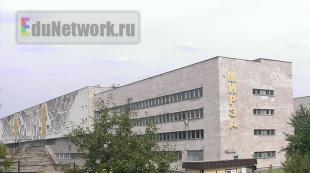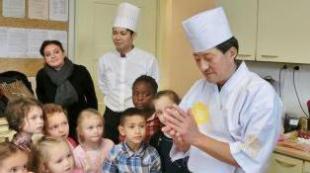Changing the position of the palatine curtain affects. Violation of the mechanism of palatopharyngeal closure. Types and forms of congenital clefts
but" and "C" andand".y " and significantly on " o "," a "," e ".
and" and "Y", the smallest for " but" uh " and " about".
The causes of rhinolalia.
1) Open organic rhinolalia may be congenital or acquired.
Congenital open rhinolalia occurs in children with clefts of the soft and hard palate ("cleft palate"), splitting of the alveolar ridge of the upper jaw and upper lip ("cleft lip"), shortening of the soft palate, hidden clefts of the hard palate.
Also, infection of a pregnant woman in the early stages of gestation (8 weeks and earlier) with toxoplasmosis, influenza, rubella, mumps, smoking, contact with pesticides, drugs, alcohol, stress.
Acquired open rhinolalia occurs as a result of cicatricial deformities, traumatic perforation of the palate, paralysis and paresis of the soft palate.
2) Closed organic rhinolalia act different kinds anatomical changes in the nasal cavity or nasopharynx.
- Anterior closed rhinolalia occurs with chronic rhinitis, leading to hypertrophy of the nasal mucosa, growths in the nasal cavity (polyps, tumors), curvature of the nasal septum.
- Posterior closed rhinolalia occurs with a decrease in the nasopharyngeal cavity. Causes: growths in the nasopharynx (large adenoid growths, fibromas, nasopharyngeal polyps, nasopharyngeal tumors).
3) Closed functional rhinolalia occurs with hypertonicity of the soft palate, which prevents the exit of the air stream through the nose. This condition can develop as a result of adenoidectomy, neurological disorders, and also against the background of copying the nasal speech of others.
4) Open functional rhinolalia occur after removal of the adenoids or with post-diphtheria paresis of the soft palate. At the same time, there is an insufficient rise of the soft palate and incomplete palatopharyngeal closure during phonation.
Features of sound pronunciation with open and closed rhinolalia.
See question # 8 and 11.
Total violation of sound penetration.
All sounds are pronounced with a nasal tinge, the most defective in this regard are vowel sounds. The articulation of consonants is shifted to the place of the missing palatopharyngeal seal, as a result of which the sounds are distorted and approach the snoring sound, sometimes resembling separate sounds.
Didactic material
For examination (presented either on cards or in reflected utterance):
and e I yu a e o y s; yay her yay ai oh yay; ifi-afa, iviava, iliala, ipiapa, ibiaba, itiata, idiada, isiasa, isiaza, ishiasha, izhiazha, ishischa, itiatsa, ichiacha, ichiaha, ikiaca, igiaga, iriara, imiama, iniana; Filya was eating waffles. Faya in the lobby. Seeing eating olives. Vova led the ox. Alla has a lily. Julia Julia Julia. Dad in the field. Paulie has a dad. Pope and Pauls sang. Lyuba loves beans. Here are the white linen. Lyuba turned white from the whitewash. The child babbles: aunt, dad. The heat melts the ice. Swans by the water. Ida goes and sings. Grandfather played the tune Wasp fell into the soup. Fox in the forest. Alesya is cheerful, etc.
Note. Used in the survey speech material must be appropriate for the age and development of the children.
In the postoperative period, when anatomical and physiological conditions have been created for the formation of correct speech, the activation of the palatine curtain and the development of mobility of the muscles of the palatopharyngeal ring acquire special significance. The solution of these tasks is facilitated by:
Massage of the soft and hard palate;
Gymnastics of the soft palate and the back of the throat.
The main goals of soft palate massage are:
stretching of scar tissue;
strengthening the performance of contractile muscles;
decrease in muscle atrophy;
improvement of local blood circulation;
activation of healing processes.
The set of exercises aimed at restoring the functional activity of the muscles of the soft palate includes passive, passive-active and active gymnastics. These exercises help to create a favorable background for the formation of accurate and coordinated work of the muscles of the palatopharyngeal ring, which is necessary for the development of a full-fledged voice.
Daily speech therapy classes should be started no earlier than 2-3 weeks after the operation and only with the permission of the surgeon. After the operation, the soft palate is swollen, sedentary, and more often motionless, its sensitivity is reduced. In the first lessons, it is necessary to achieve the development of his mobility. Exercises should be performed 6-8 times a day until the trembling appears, and then the movements of the soft palate.
The operated soft palate is prone to scarring, as a result of which it is shortened. Therefore, as soon as there is a slight mobility of the soft palate, the speech therapist conducts exercises that help stretch the scar tissue and dissolve the scars.
After the soft palate is held in the ascent for 1-2 seconds, we proceed to normalize the pronunciation of vowel phonemes. These exercises allow you to increase the musculature of the pharynx in a volume sufficient to ensure palatopharyngeal closure.
Activation of the tip and back of the tongue, moving it forward in the oral cavity occurs in parallel with the activation of the soft palate.
To form speech breathing during the differentiation of inhalation and exhalation through the nose and mouth.
Activate the palatine curtain (after the operation, it is shortened due to tissue scarring). Paying great attention to the activation of the palatine curtain, we thereby create conditions for intensive exhalation. The work on breathing correction begins with the development of a directed air stream through the mouth. We stimulate diaphragmatic (lower costal) breathing and
differentiation of oral and nasal breathing (working out various types of inhalation and exhalation).
The purpose of the exercises:
To strengthen the diaphragmatic inhalation and gradual calm exhalation in the process of learning different types of inhalation and exhalation;
Lay the foundations of the rhythm of speech breathing with a pause after inhalation.
Phonetic-phonemic underdevelopment (FFN) is understood as a violation of the process of formation of the pronunciation system native language in children with various speech disorders due to defects in perception and pronunciation of phonemes. The main feature of phonetic-phonemic underdevelopment is a low ability to analyze and synthesize sounds, which affects the perception of the phonemic composition of the language.
Stages of the formation of phonemic perception... The formation of phonemic perception occurs in six stages. Each stage contains a sequence of tasks, taking into account the principle "from simple to difficult". Recognition of non-speech sounds. Distinguishing the same sound-complexes in height, strength, timbre. Distinguishing words that are similar in sound composition.
Stage 1 - "Recognition of non-speech sounds." The sounds of the surrounding world. Sounding toys. Play rhythm. Isolated strikes. A series of simple punches.
4-5 objects are displayed in front of the child (metal box, glass jar, plastic cup, wooden box), when tapping on which you can hear different sounds. With the help of a pencil, the speech therapist calls out the sound of each object, reproduces it repeatedly until the student catches the nature of the sound.
Exercise "Snowman". Children "draw" with their hands three different-sized circles - "snowmen" and sing 3 sounds of different pitch.
Stage 2 - "Distinguishing the same sound-complexes in height, strength and timbre" Exercise "Learned Bear and Sparrow". Big bear - low, heavy sounds children sing - E-E-E, sparrow - high sounds - chik-chirik.
Stage 3 - "Distinguishing between words that are similar in sound composition." You can invite the children to take two circles: yellow and blue and invite them to play. If the child hears the correct name of the object shown in the picture, he must raise the yellow circle, if the wrong one - blue. Complicating the work, you can offer this type of work: name the objects shown in the pictures, and connect those of them whose names sound similar. - Listen to the rhyme, find the "wrong word" in it and replace it with a word similar in sound composition and appropriate in meaning: Mom scolded the bunny - did not put the NUT (MAIKU) under the sweater. There is a lot of snow in the yard - TANKS are driving along the mountain, etc.
Stage 4 - "Reproduction and differentiation of syllables." It is proposed to use the following types of exercises: To reproduce combinations of syllables with a common consonant sound: MU-MY-MA; NO-ON-NU; Play combinations of syllables with a common vowel: TA-KA-PA; To reproduce combinations of syllables with differences in hardness and softness: MA-MYA; Play combinations of syllable pairs, gradually increasing the consonant sound: PA-TPA; Play combinations of syllables with a common confluence of two consonants and different vowels: PTA-PTO-PTU-PTY.
Stage 5 - "Differentiation of phonemes, clarification of sound articulation based on perception and sensation." At the stage of phoneme differentiation, children learn to distinguish between the phonemes of their native language. You need to start with vowel differentiation.
1. "Find a pair." Purpose: to consolidate knowledge about the vowels of the first and second row. An adult names a first row vowel, and a child names a second row vowel and vice versa. (A-Z, O-Y, U-Y, E-E, Y-I)
2. "Insert a letter." Purpose: to consolidate knowledge about the vowels of the first and second row. The child needs to insert the missing vowel (a separate exercise is given for each pair). Insert A-Z: m… .h, m… k, s… .d, t…. Kidneys, gr… h,… block. Then with consonants. Purpose: to consolidate the ability to distinguish between hard and soft consonants.
3. An adult shows pictures depicting objects (from any board game such as loto). The child must arrange these pictures in two piles: words that begin with a hard consonant and words that begin with a soft consonant.
6 stage - Development of the skills of elementary sound analysis. "Name the sound" Purpose: development of auditory attention. Task: an adult pronounces 3 - 4 words, the child must name a sound that is repeated in all words. Fur coat, machine, baby, commander's dry, tube, mole, lynx, etc.
A feature of this system is that the formation of phonemic perception is carried out in a playful way in subgroup, individual, frontal classes and in the correctional work of a speech therapist.
Special emphasis in corrective work is placed on activation of speech motor skills... In children with rhinolalia, by the time of training, as a rule, pathological features of articulation have already been formed, due to a defect in the anatomical structure of the speech apparatus. Their elimination is the most important section of the corrective action, since the full-fledged work of the articulation organs is necessary to establish the correct sound pronunciation. It is necessary, on the one hand, to free the articulatory muscles from tension, stiffness, on the other hand, on the contrary, from lethargy, weakness, pareticity.
The complex of activities includes:
Massage of articulatory and facial muscles;
Gymnastics of the articulatory apparatus and facial muscles.
Articulatory gymnastics and massage help to activate the motor function of the articulatory apparatus - they improve movement, mobility, switchability and allow to bring up certain kinesthetic sensations, to form a certain articulatory way.
The tasks of speech therapy massage include:
1) weaken pathological manifestations in the organs of the articulatory apparatus;
2) prepare the articulatory apparatus for performing muscle movements necessary for correct sound pronunciation;
3) restore faded reflexes;
4) enhance tactile sensations.
In addition to massage, articulatory gymnastics contributes to the formation of correct articulation patterns and precise articulatory movements. When working with children with rhinolalia, articulatory gymnastics serves:
1) elimination of the high rise of the root of the tongue and its displacement deep into the oral cavity;
2) the development of full-fledged labial articulation;
3) elimination of excessive participation of the root of the language in the pronunciation of sounds;
4) the sequential formation of involuntary, and then voluntary mimic movements;
5) the development of stable motor and speech kinesthesias, the development of differentiated kinesthetic perception;
6) strengthening the entire muscular background.
The main purpose of using articulatory gymnastics is to develop clarity, directionality of movements of the entire articulatory apparatus and coordination of its work with the respiratory and voice organs.
The activation of the articulatory apparatus takes a long time. In the complexes of articulatory gymnastics, in order to develop the functions of the speech apparatus, passive and active gymnastics is carried out. At the initial stages of work, children perform exercises with the help of a speech therapist (passive gymnastics). Gradually move on to training active movements. Spend articulatory gymnastics it is necessary every day that the articulation skills developed in the child are consolidated and automated.
When a speech therapy examination of a child with rhinolalia, Gutsman's tests can be used to determine a hidden (submucous) cleft. 1. Gutszman's tests: First, the child is asked to alternately pronounce the vowels A and I, while the nasal passages are either pinched or opened. With the open form, there is a significant difference in the sound of these vowels: with a closed nose, sounds, especially I, are muffled and at the same time the speech therapist's fingers feel a strong vibration on the wings of the nose. 2. Examination using a phonendoscope. The speech therapist inserts one olive into his ear, the other into the child's nose. When pronouncing the vowels, especially [U] and [I], a strong hum is heard - this is an indicator of a hidden submucous cleft.
Speech therapy examination for rhinolalia begins with an examination of the articulatory apparatus. From documents, conversations, inspection, the type of cleft is classified. The age and type of operation are revealed, the state of the organs of articulation is described in detail. With a cleft of the upper lip, its mobility, the severity of cicatricial changes, the condition of the bridle are noted.
The palate before the operation is described: the type of cleft, the size of the defect, the mobility of the segments of the soft palate. The palate after surgery is described as follows: the shape of the vault, scars, their degree of severity, the length and mobility of the palatine curtain. The palate is normal - at rest, the small uvula is 1-7 mm from the posterior wall of the pharynx, hanging from the plane of the chewing surfaces of the upper teeth by about 1 mm. The mobility of the palatine curtain is checked with a smooth, drawn-out pronunciation [A], with a wide open mouth. The density of the palatopharyngeal closure and the activity of the lateral walls of the pharynx during phonation are noted. Pronunciation of vowels can reveal the immobility of the soft palate. The speech therapist triggers the pharyngeal reflex by touching the back and side walls of the pharynx with a spatula. If the functions of the soft palate are not impaired, then an involuntary jerk of the palatine curtain should occur. The pharyngeal reflex is assessed: absent, preserved, increased or decreased. Attenuation of the reaction of the pharyngeal muscles can begin at 5 and end at 7 years. Evaluation is essential for children who will be wearing a functional pharyngeal obturator. Examination of the tongue The condition of the root and tip of the tongue is examined, there is a shift in the oral cavity, excessive tension, lethargy, limitation of mobility. The child performs exercises: a needle, a snake, a spatula, a horse, a watch, a swing, delicious jam. All exercises are carried out by imitation, then according to the instructions in front of a mirror and without it. Examination of the dentition The state of the bite, dentition. The presence of the orthodontic apparatus, the purpose of the application, the density of fixation, interferes or does not interfere with phonation are recorded. At the end of the examination, the directionality of the upper lip is checked. Exercises: focus, spit, blowing a light object into the target. Blow with tongue sticking out, with closed and open wings of the nose.
Sound pronunciation is checked in the same way as for dislalia. Preschoolers are presented with clarity, students can be offered texts. The nature of pronunciation disorders is noted: additional silent pronunciation, i.e. articulation without phonation, accompanying noises. Legibility or illegibility, blurredness, nasal resonances must be noted. When examining all aspects of speech, phonemic hearing and perception are first checked. The examination proceeds as in the case of dyslalia. Material with paronyms (hatch-bow) must be selected. For older preschoolers and younger students, the state of the sound-letter analysis is checked. Words are taken with solid consonant variants. Unlike dyslalia, they clarify whether the child differentiates his / her deficiencies by ear or knows about them from the words of others.
The state of the vocabulary is examined, the level of the passive and active vocabulary is checked. The grammatical structure of speech is examined. The state of coherent speech is checked using the example of dialogue and monologue. Schoolchildren have their writing and reading checked. Writing: cheating, dictation, self-expression. Reading: the way of reading is checked (letter by letter, syllabic, verbal), reading comprehension is examined.
The structure and functioning of the pharyngeal apparatus during normal development. The value of the palatopharyngeal closure in the formation of nasal and oral, vowel and consonant sounds.
The palate is normally a mass that separates the mouth, nose and throat. It consists of a hard and soft palate. Solid has a bone base. In front and on the sides, it is framed by the alveolar process of the upper jaw with teeth, and behind it is the soft palate. The hard palate is covered with a mucous membrane, the surface of which behind the alveoli has an increased tactile sensitivity. The height and configuration of the hard palate affects resonance.
The soft palate is the posterior part of the septum between the cavities of the nose and mouth. The soft palate itself represents muscle formation. The front third of it is practically motionless, the middle one is most actively involved in speech, and the back one is in tension and swallowing. The soft palate is anatomically and functionally connected to the pharynx, palatopharyngeal mechanism participates in breathing, swallowing and speech.
When breathing, the soft palate is lowered and partially covers the opening between the pharynx and the oral cavity. When swallowing, the soft palate stretches, rises and approaches the back wall of the pharynx, which accordingly moves towards and comes into contact with the palate. At the same time, other muscles contract: the tongue, the lateral walls of the pharynx, its upper constrictor.
In the process of speech, a very rapid muscle contraction is constantly repeated, which brings the soft palate closer to the posterior wall of the pharynx in the upward and posterior direction. The soft palate moves up and down very quickly during speech: the time for opening or closing the nasopharynx ranges from 0.01 to 1 second. The degree to which it is raised depends on the fluency of speech, as well as on the phonemes that are being pronounced at the moment. The maximum lifting of the palate is observed when pronouncing the sounds " but" and "C" and its greatest stress at " and". This voltage decreases slightly at “ y " and significantly on " o "," a "," e ".
In turn, the volume of the pharyngeal cavity changes with the phonation of different vowels. The pharyngeal cavity occupies the largest volume when pronouncing the sounds " and" and "Y", the smallest for " but" and intermediate between them at “ uh " and " about".
When blowing, swallowing, whistling, the soft palate rises even higher than during phonation, and closes the nasopharynx, while the pharynx narrows. However, the mechanisms of the palatine-pharyngeal closure during speech and non-speech activity are different.
Definition of rhinolalia
This is a violation of sound pronunciation and timbre of the voice due to anatomical and physiological defects of the speech apparatus. The pronunciation of both consonants (voiced and voiceless) and vowels suffers. Not only sound pronunciation suffers, but also the voice. The presence of a nasal tone of voice distinguishes rhinolalia from dyslalia, which is characterized only by a violation of sound pronunciation.
Depending on the nature of the damage to the speech apparatus, the nature of the anatomical defect and dysfunction of the palatopharyngeal closure, rhinolalia manifests itself in 3 types - open, closed and mixed. By etiology, it can be organic and functional.
Causes and mechanism of speech impairment in rhinolalia: modern approaches.
Pathological features of the structure and activity of the speech apparatus cause various deviations in the development of not only the sound side of speech, various structural components of speech suffer to varying degrees.
In oral speech, impoverishment and abnormal conditions for the course of the dolinguistic development of children with rhinolalia are noted. In connection with the violation of the speech-motor periphery, the child is deprived of intensive babbling, articulatory "play", thereby depleting the stage of preparatory tuning of the speech apparatus.
Not only the articulation of sounds suffers, but also the development of the prosodic elements of speech.
Late onset of speech is noted, a significant time interval between the appearance of the first syllables, words and phrases already in the early period, that is, a distorted path of development of speech as a whole begins. To the greatest extent, the defect manifests itself in the violation of its phonetic side.
The most significant manifestations of defective phonetic design of oral speech are violations of all oral sounds of speech due to the connection of the nasal resonator and changes in the aerodynamic conditions of phonation. Sounds become nasal.
In addition, the specific coloring of some consonant sounds (more often the posterior palatine) is revealed due to the connection of the pharyngeal resonator.
There are also phenomena of additional articulation in the laryngeal cavity, which gives speech a kind of "clicking" sound.
Many other more specific defects are revealed. For example: lowering the initial consonant ("ak, am" - so, there); neutralization of dental sounds by the method of formation, replacement of explosive sounds with fricatives; whistling background when pronouncing hissing sounds or vice versa; no vibrant R or sound replacement s with a strong exhalation; the imposition of additional noise on nasalized sounds (hiss, whistling, aspiration, snoring, larynx, etc.); moving articulation to more posterior zones.
The speech of a child with rhinolalia is generally not legible.
Thus, the mechanism of impairment in open rhinolalia is determined by the following:
1) the absence of the palatine-pharyngeal seal and, as a result, a violation of the opposition of sounds on the basis of the oral-nasal one;
2) a change in the place and method of articulation of most sounds due to defects in the hard and soft palate, lethargy of the tip of the tongue, lips, moving the tongue deep into the oral cavity, high position of the root of the tongue, participation in the articulation of the muscles of the pharynx and larynx.
Features of the letter. The peculiarities of the pronunciation of children with rhinolalia lead to the distortion and lack of formation of the phonemic system of the language.
The secondary conditioned peculiarities of the perception of speech sounds are the main obstacle to mastering the correct writing.
The connection between writing disorders and defects in the articulatory apparatus has various manifestations. If by the time of learning a child with rhinolalia has mastered intelligible speech, is able to clearly pronounce most of the sounds of his native language and only a slight nasal shade remains in his speech, then the development of sound analysis necessary for teaching literacy is proceeding successfully. However, as soon as the "child with rhinolalia" has additional obstacles to normal speech development, specific violations of the letter are manifested.
The dysgraphic errors that are observed in the written work of children with cleft palates are varied.
Specific to rhinolalia are substitutions P, b on m, t, d on the n and reverse replacements n - d, t, m - b, n, due to the absence of phonological opposition of the corresponding sounds in oral speech, gaps, substitutions, the use of sticky vowels are revealed, substitutions and mixing of sibilant-sibilants are common, difficulties in using affricates, sound c is replaced by s, mixing of voiced and voiceless consonants is characteristic, mistakes are often made to skip one letter from the confluence, the sound l replaced p, p on the l.
The degree of writing impairment depends on a number of factors: the depth of the defect in the articulatory apparatus, personality traits and compensatory capabilities of the child, the nature and timing of speech therapy, the influence of the speech environment.
general characteristics rhinolalia.
Rhinolalia(from the Greek. nose + speech) - violation
timbre of voice and sound pronunciation, due to anatomical and physiological
defects of the speech apparatus.
Rhinolalia in its directions differs from dyslalia by the presence of a modified
nasalized
(lat. nose) timbre of voice.
With rhinolalia, the articulation of sounds, phonation differ significantly from the norm.
With normal phonation during the pronunciation of all speech sounds, except for nasal ones, in a person
there is a separation of the nasopharyngeal and nasal cavity from the pharyngeal and oral cavity.
These cavities are separated by the palatopharyngeal closure caused by the contraction of the muscles of the soft
palate, lateral and posterior pharyngeal walls.
Simultaneously with the movement of the soft palate during phonation, the posterior pharyngeal wall thickens
(Passavant roller), which contributes to the contact of the back surface of the soft
the palate with the back of the pharynx.
During speech, the soft palate continuously descends and rises to different heights depending on
from the sounds spoken and the rate of speech. The strength of the palatopharyngeal closure depends on
pronounced sounds. It is less for vowels than for consonants. The weakest
palatine-pharyngeal closure is observed with a consonant in
, the strongest is at from
,
usually 6-7 times stronger than but.
With normal pronunciation of nasal sounds m, m "
,n, n "
air jet
freely penetrates into the space of the nasal cavity.
Depending on the nature of the dysfunction of the palatine-pharyngeal closure, various
rhinolalia forms. The presence of congenital palatine clefts deeply affects the entire development of the child: this
children are painful, somatically weakened, they often have a decrease
hearing. With rhinolalia, speech defect may be accompanied by developmental abnormalities.
higher mental functions. These patients are characterized by peculiar
features of personality development and the formation of activities.
The speech defect of rhinolalica from birth is due to a number of reasons.
First of all, the provision of vital functions of respiration and nutrition leads to
the specific position of the body of the tongue (with an excessively raised root). Such
the position of the language leads to a violation of its functionality, on one
hand, and to defective compensation for the violation - on the other (during speech in
articulation involves the muscles of the face, forehead, there are various synkinesias).
With rhinolalia, the formation of atypical specific respiration is noted, the development
hypernasalization and defects in articulation of sounds.
In the picture of a speech disorder, defective sound reproduction is the leading one, for the second time it can
suffer the lexical and grammatical structure of speech, phonemic hearing, writing
speech. Correction of the defect is carried out by means of medical, speech therapy and psychological and pedagogical
impact.
To understand the mechanism of occurrence of these anomalies, one should study the process of lip and palate formation.
The formation of the lip and palate begins at 5-10 weeks of intrauterine life; there is a division of the primary oral cavity into two sections:
oral cavity and nasal cavity.
This is due to the formation of lamellar protrusions of the palatine processes on the inner surfaces of the maxillary processes. At the beginning eighth week the edges of the palatine processes are directed obliquely downward and lie along the bottom of the oral cavity, on the sides of the tongue. The lower jaw is enlarged. The tongue descends into this space, making it possible to move the palatine processes from a vertical position to a horizontal one.
In the end second month the life of the embryo, the edges of the palatine processes begin to connect with each other, begins in the anterior sections and gradually spreads posteriorly. The septum of the mouth bay is the rudiment of a hard and soft palate. It separates the final oral cavity from the nasal cavity. At the same time, the growth of the nasal septum occurs, which grows together with the palate and divides the nasal cavity into the right and left nasal chambers.
by the 11th week, a lip and a hard palate are formed,
and by the end of the 12th week, fragments of the soft palate grow together with each other. The condition of the lip and palate in the embryo at certain stages of development is the same as in nonunions observed in the clinic: from a through bilateral fissure defect of the lip, alveolar ridge and palate to nonunion of only the soft palate and even only the uvula or latent nonunion of the lip. Conventionally, this condition of the lip or palate can be called a physiological cleft. Under the influence of one or more of the listed etiological factors, the fusion of the edges of the "physiological clefts" is delayed, which leads to congenital nonunion of the lip, palate, or a combination of them.
One of the pathogenetic factors of non-union of the halves of the palate is obviously the pressure of the tongue, the size of which, as a result of the discorrelation of growth, turned out to be larger than usual. Such a discrepancy can arise on the basis of hormonal metabolic disorders in the mother's body.
Topic 3. Causes and mechanisms of disorders in rhinolalia
.Rhinolalia reasons.
Types and forms of congenital clefts.
Classification of rhinolalia.
The mechanism of occurrence of speech disorders in rhinolalia.
Mechanisms of impairment of speech breathing, voice formation and sound pronunciation.
Etiology
Etiological factors of anomalies in the human body, including the maxillofacial region, are divided into exogenous and endogenous.
TO exogenous factors relate:
1) physical (mechanical and thermal effects; external and internal ionizing radiation);
2) chemical (hypoxia, maternal malnutrition during critical periods of embryo development, lack of vitamins (retinol, tocopherol acetate, thiamine, riboflavin, pyridoxine, cyanocobalamin), as well as essential amino acids and iodine in the mother's food; hormonal discorrelations. cause fetal hypoxia and deformities in it, the effect of chemical compounds that mimic the effect of ionizing radiation, such as mustard gas;
H) biological (measles viruses, mumps, shingles, bacteria and their toxins);
4) mental (cause hyperadrenalinemia).
TO endogenous factors belong to:
1) predisposition to pathological heredity (there is no gene carrying a hereditary predisposition to non-union)
2) biological inferiority of cells;
H) the influence of age and gender.
In the history of patients and their parents, it is often possible to establish the following factors, with which the appearance of birth defects has to be associated: infectious diseases transferred by the mother during pregnancy; toxicosis, spontaneous and induced abortion; severe physical injury at 8–12 weeks of gestation; diseases of the genital area; severe mental trauma to the mother; late childbirth; malnutrition of the mother.
Types and forms of congenital clefts
Congenital underdevelopment of the palate includes:
1) congenital cleft palate and lip
2) submucosal clefts;
3) congenital underdevelopment of the palate;
4) congenital asymmetry of the face with deformation of the palate.
Most often in practice, there are clefts of the lip and palate. The forms of palatine clefts are extremely diverse, but they all lead to speech impairment.
Cleft lips. Distinguish between partial and complete cleft lip. The anatomical structure and size of the lips in children and adults vary considerably.
A normally developed upper lip has the following anatomical components:
1) filter 2) two columns; H) red border; 4) the median tubercle; 5) the line, or arc, of Cupid. This is the name of the line separating the red border and the skin of the upper lip.
When treating a child with a congenital lip defect, the surgeon must recreate all of the listed elements.
Classification. In accordance with the clinical and anatomical features, congenital defects of the upper lip are divided into several groups.
1.non-union of the upper lip is divided into lateral - unilateral(accounting for about 82%), bilateral.
2.on partial(when the non-union has spread only to the red border or simultaneously with the red border there is a non-union of the lower part of the skin part of the lip
and full- within the entire height of the lip, as a result of which the wing of the nose is usually deployed due to non-union of the base of the nostril
Cleft palate. The palate is normally a mass that separates the mouth, nose and throat. It consists of a hard and soft palate. Solid has a bone base. In front and on the sides, it is framed by the alveolar process of the upper jaw with teeth, and behind it is the soft palate. The hard palate is covered with a mucous membrane, the surface of which behind the alveoli has an increased tactile sensitivity. The height and configuration of the hard palate affects resonance.
The soft palate is the posterior part of the septum between the cavities of the nose and mouth. The soft palate represents muscle formation. The front third of it is practically motionless, the middle one is most actively involved in speech, and the back one is in tension and swallowing. Ascending, the soft palate lengthens. At the same time, there is a thinning of its anterior third and a thickening of the posterior one.
The soft palate is anatomically and functionally connected with the pharynx, the palatopharyngeal mechanism is involved in breathing, swallowing and speech.
When breathing, the soft palate is lowered and partially covers the opening between the pharynx and the oral cavity. When swallowing, the soft palate stretches, rises and approaches the back wall of the pharynx, which accordingly moves towards and comes into contact with the palate. At the same time, other muscles contract: the tongue, the lateral walls of the pharynx, its upper constrictor.
When blowing, swallowing, whistling, the soft palate rises even higher than during phonation, and closes the nasopharynx, while the pharynx narrows.
Palatine-pharyngeal insufficiency means a violation of the normal physiological interaction of the structures of the palatine-pharyngeal ring. In children with congenital clefts of the palate after plastic surgery of the palate, palatine-pharyngeal insufficiency is a consequence of insufficiently complete closure of the soft palate with the posterior pharyngeal wall and manifests itself in the form of a speech disorder - rhinolalia. Indistinct speech, nasal sounds, nasal emissions (audible leakage of air from the mouth into the nasal cavity) and compensatory mechanisms of articulation (including compensatory grimaces on the face) are typical signs of pharyngeal insufficiency.
The main cause of opharyngeal insufficiency is insufficiently full participation of the soft palate in the mechanism of opharyngeal closure: in some cases the soft palate is too short, in others it is not sufficiently mobile.
The main reasons for the formation of palatine-pharyngeal insufficiency:
the use of surgical techniques leading to the formation of a shortened soft palate;
performing primary plastic surgery of the palate after the first year of life;
violation of normal healing processes in the postoperative period.
Methods for diagnosing небopharyngeal insufficiency
The simplest and most accessible method for diagnosing palatine-pharyngeal insufficiency is speech therapy examination and testing. It is carried out by a highly qualified speech therapist and is based on the detection of nasal and nasal emission when pronouncing special words that require the complete closure of the palatine-pharyngeal ring (read).
The most objective method for studying the function of the palatine-pharyngeal ring is fibrooptic nasopharyngoscopy. During this examination, the doctor can not only visualize all structures of the palatine-pharyngeal ring and assess the degree of their participation in the closure process, but also determine the size of the residual opening between the soft palate and the posterior pharyngeal wall immediately at the moment of closure.
Based on the results of speech therapy testing and nasopharyngoscopy, in the course of a joint consultation, the operating surgeon and the speech therapist choose the most optimal way to eliminate the pharyngeal insufficiency.
Nasopharyngoscopy is a standard procedure used to diagnose opharyngeal insufficiency
Treatment methods
The program for the treatment of children with palatal-pharyngeal insufficiency developed at the center includes the following stages:
1. Courses of speech therapy training in a hospital or in a center polyclinic.
2. Speech therapy and nasopharyngoscopy.
3. Depending on the results of the examination - continuation of speech therapy training or surgical treatment (reconstruction of the soft palate or the use of pharyngeal tissue to achieve palatal-pharyngeal closure).
Note!
Rhinolalia is a speech pathology that is observed in almost 100% of cases in children with congenital clefts of the palate after late plastic surgery of the palate.
The optimal prevention of its appearance is the performance of a plastic surgery of the palate before the age of 1 year. However, rhinolalia is a reversible pathology, its manifestations can be eliminated by conducting speech therapy courses.
Diagnosis palatine-pharyngeal - means that after repeated courses of speech therapy training, clinical signs of rhinolalia persist, and with nasopharynoscopy, there is a significant area of non-closure of the soft palate with the posterior pharyngeal wall. This usually implies the need for surgical treatment.
To understand the mechanism of occurrence of these anomalies, one should study the process of lip and palate formation.
The formation of the lip and palate begins at 5-10 weeks of intrauterine life; there is a division of the primary oral cavity into two sections:
oral cavity and nasal cavity.
This is due to the formation of lamellar protrusions of the palatine processes on the inner surfaces of the maxillary processes. At the beginning eighth week the edges of the palatine processes are directed obliquely downward and lie along the bottom of the oral cavity, on the sides of the tongue. The lower jaw is enlarged. The tongue descends into this space, making it possible to move the palatine processes from a vertical position to a horizontal one.
In the end second month the life of the embryo, the edges of the palatine processes begin to connect with each other, begins in the anterior sections and gradually spreads posteriorly. The septum of the mouth bay is the rudiment of a hard and soft palate. It separates the final oral cavity from the nasal cavity. At the same time, the growth of the nasal septum occurs, which grows together with the palate and divides the nasal cavity into the right and left nasal chambers.
by the 11th week, a lip and a hard palate are formed,
and by the end of the 12th week, fragments of the soft palate grow together with each other. The condition of the lip and palate in the embryo at certain stages of development is the same as in nonunions observed in the clinic: from a through bilateral fissure defect of the lip, alveolar ridge and palate to nonunion of only the soft palate and even only the uvula or latent nonunion of the lip. Conventionally, this condition of the lip or palate can be called a physiological cleft. Under the influence of one or more of the listed etiological factors, the fusion of the edges of the "physiological clefts" is delayed, which leads to congenital nonunion of the lip, palate, or a combination of them.
One of the pathogenetic factors of non-union of the halves of the palate is obviously the pressure of the tongue, the size of which, as a result of the discorrelation of growth, turned out to be larger than usual. Such a discrepancy can arise on the basis of hormonal metabolic disorders in the mother's body.
Topic 3. Causes and mechanisms of disorders in rhinolalia
.Rhinolalia reasons.
Types and forms of congenital clefts.
Classification of rhinolalia.
The mechanism of occurrence of speech disorders in rhinolalia.
Mechanisms of impairment of speech breathing, voice formation and sound pronunciation.
Etiology
Etiological factors of anomalies in the human body, including the maxillofacial region, are divided into exogenous and endogenous.
TO exogenous factors relate:
1) physical (mechanical and thermal effects; external and internal ionizing radiation);
2) chemical (hypoxia, maternal malnutrition during critical periods of embryo development, lack of vitamins (retinol, tocopherol acetate, thiamine, riboflavin, pyridoxine, cyanocobalamin), as well as essential amino acids and iodine in the mother's food; hormonal discorrelations. cause fetal hypoxia and deformities in it, the effect of chemical compounds that mimic the effect of ionizing radiation, such as mustard gas;
H) biological (measles viruses, mumps, shingles, bacteria and their toxins);
4) mental (cause hyperadrenalinemia).
TO endogenous factors belong to:
1) predisposition to pathological heredity (there is no gene carrying a hereditary predisposition to non-union)
2) biological inferiority of cells;
H) the influence of age and gender.
In the history of patients and their parents, it is often possible to establish the following factors, with which the appearance of birth defects has to be associated: infectious diseases transferred by the mother during pregnancy; toxicosis, spontaneous and induced abortion; severe physical injury at 8–12 weeks of gestation; diseases of the genital area; severe mental trauma to the mother; late childbirth; malnutrition of the mother.
Types and forms of congenital clefts
Congenital underdevelopment of the palate includes:
1) congenital cleft palate and lip
2) submucosal clefts;
3) congenital underdevelopment of the palate;
4) congenital asymmetry of the face with deformation of the palate.
Most often in practice, there are clefts of the lip and palate. The forms of palatine clefts are extremely diverse, but they all lead to speech impairment.
Cleft lips. Distinguish between partial and complete cleft lip. The anatomical structure and size of the lips in children and adults vary considerably.
A normally developed upper lip has the following anatomical components:
1) filter 2) two columns; H) red border; 4) the median tubercle; 5) the line, or arc, of Cupid. This is the name of the line separating the red border and the skin of the upper lip.
When treating a child with a congenital lip defect, the surgeon must recreate all of the listed elements.
Classification. In accordance with the clinical and anatomical features, congenital defects of the upper lip are divided into several groups.
1.non-union of the upper lip is divided into lateral - unilateral(accounting for about 82%), bilateral.
2.on partial(when the non-union has spread only to the red border or simultaneously with the red border there is a non-union of the lower part of the skin part of the lip
and full- within the entire height of the lip, as a result of which the wing of the nose is usually deployed due to non-union of the base of the nostril
Cleft palate. The palate is normally a mass that separates the mouth, nose and throat. It consists of a hard and soft palate. Solid has a bone base. In front and on the sides, it is framed by the alveolar process of the upper jaw with teeth, and behind it is the soft palate. The hard palate is covered with a mucous membrane, the surface of which behind the alveoli has an increased tactile sensitivity. The height and configuration of the hard palate affects resonance.
The soft palate is the posterior part of the septum between the cavities of the nose and mouth. The soft palate represents muscle formation. The front third of it is practically motionless, the middle one is most actively involved in speech, and the back one is in tension and swallowing. Ascending, the soft palate lengthens. At the same time, there is a thinning of its anterior third and a thickening of the posterior one.
The soft palate is anatomically and functionally connected with the pharynx, the palatopharyngeal mechanism is involved in breathing, swallowing and speech.
When breathing, the soft palate is lowered and partially covers the opening between the pharynx and the oral cavity. When swallowing, the soft palate stretches, rises and approaches the back wall of the pharynx, which accordingly moves towards and comes into contact with the palate. At the same time, other muscles contract: the tongue, the lateral walls of the pharynx, its upper constrictor.
When blowing, swallowing, whistling, the soft palate rises even higher than during phonation, and closes the nasopharynx, while the pharynx narrows.









